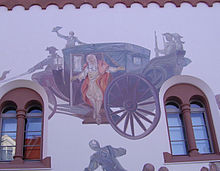Landau


A landau is a four-seater, four-wheeled carriage with springs on both axles with two bench seats arranged opposite and parallel. The convertible top is usually divided in the middle and foldable, occasionally also in one piece. It is a so-called "convertible" carriage, i. That is, it can be converted from an open to a completely closed car, versions are known in which a fixed part of the roof remains in the middle of the car. The type of top has been figuratively documented since at least the 17th century. Due to the connection with the suspension of the half-open berline , presumably developed in France before the 18th century, the Landau became the preferred touring car and status symbol of the wealthy in all European countries in the 18th and 19th centuries .
The design of the Landaulet is derived from the Landauer , in which only the rear half of the convertible top can be opened.
etymology
The origin of the name Landauer is disputed and cannot be decided with certainty based on the known evidence.
Derivations from German bring the carriage name in connection with the place name Landau, and then especially with Landau in the Palatinate . There wagons of this type are said to have been built first or in a special quality, as Goethe also suggests when in Hermann and Dorothea the "first merchant" of the scene on the right bank of the Rhine in the "open wagon (it was made in Landau)" (1.56) moves. Or the name is said to have originated when King Joseph I drove from Vienna to Landau in the Palatinate in 1702 to take over the command of the siege of what was then a French border fortress : the sensational event at the time in which the king and a retinue from over 250 people in 77 carriages covered the route in 14 daily stages, is said to have permanently linked the new type of touring car used with the name Landaus.
An “Arabic” thesis of origin derives the name from the Arabic al-andul (“sedan chair , wagon”, from old Indian Hindola “swing”): the word is supposed to be taken from Arabic in the form of lando (“four-seater mule cart ”) into Spanish, from there in the form of landau migrated into English, French and German and in German only then associated with the place name Landau through folk etymological reinterpretation and transformed into Landauer .
The Arabic derivation offers the advantage that it does without anecdotal (Joseph I's trip to Landau) or historically questionable (origin of the Landau in Landau in the Palatinate). However, it contradicts the chronology of the known evidence: since the word is used as a coach name in German as early as 1723 (English 1743), but in Spanish not until 1830, it is more likely that it is not from Arabic but from French ( 1814) was adopted into Spanish and so in the last instance can probably be derived from the German place name.
The early documents know the Landauer ( Landauer Schwimmerl , Landauer Wagen , Landauer Chaise ) as a mostly six-horse touring car, for example 1709, 1734, 1743, 1745 or 1756.
Landauer as an automobile body

While the Landaulet, derived from the Landau, was quite widespread at the beginning of motorization and still exists as a niche product today, very few Landau were produced as motorized carriages. However, representative landaulets with four to six seats in the rear took over the number of seats from the landau. The benches were often arranged facing each other, which also goes back to the Landauer.
Other uses of the term
- for other carriages with two benches and a two-part hood.
- In French, strollers with a hood are also called Landau .
literature
- Friedrich Kluge, Elmar Sebold (arrangement): Etymological dictionary of the German language . de Gruyter, Berlin & New York, 23 exp. Edition 1995, ISBN 3-11-012922-1
- Nabil Osman: Small lexicon of German words of Arabic origin . Verlag CH Beck, Munich 1982, 7th edition 2003, ISBN 3-406-47584-1
- Paul Jäger, Rudolf Wackernagel, Albert Fritz: The Landauer, a European touring car . Palatinate Publishing House, Landau 1985
- Karl Lokotsch: Etymological dictionary of European (Germanic, Romanic and Slavic) words of oriental origin . Winter, Heidelberg 1925 (= Indo-European Library, 1st section, 2nd row, vol. 3)
Web links
- Pablo Günther: The Casanova Tour. A manual for the use of the private touring car in Europe and America in the 18th century (Copyright 2002/2006)
- coachbuilt.com: Terminology (accessed August 30, 2013)
- Transport workshop: Landauer (Fig.) (Accessed on August 30, 2013)
- Encyclopedia Britannica Online on the Landau as a carriage design (accessed August 30, 2013)
- Encyclopedia Britannica Online: Landau, 1890; in the Long Island Museum of American Art, History & Carriages, Stony Brook, NY (fig. ) (accessed August 30, 2013)
Individual evidence
- ↑ a b c coachbuilt.com: Terminology
- ↑ Document from 1709 , document from 1734 , two documents from 1743 , document from 1745 , document from 1756
